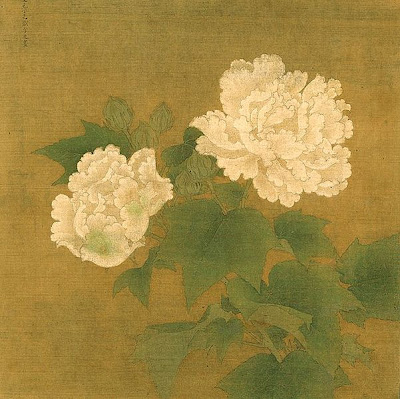It usually happens during conversations about art that someone would ask me who or which artists I like. There is no simple answer because so many names come to mind. Not only have great artists from the past influenced me, but also local artists and artisans inspire me in many ways.
Flowers are in my life. I have a simple flower garden, and sometimes I'm given a special bouquet (or, I treat myself). Many artists paint flowers or show flowers within their paintings . . . some names may surprise you. Remember those colorful crayon "masterpieces" you brought home from grade school? And remember those collage flower projects made with dyed cotton balls, crumpled tissue paper, beads or dried pasta shapes? A gift of fresh flowers convey friendship, love, and happiness. Whenever words fail us, we send flowers during times of sadness and loss. The English critic, artist, and writer John Ruskin (1819-1900) said: "Flowers seem intended for the solace of ordinary humanity."
Li Di literally produced blooms with vivid realism. Li Di was a Chinese imperial court painter during the Southern Song Dynasty (1127–1279) era. He produced two exquisite hibiscus flower paintings (Pair of album leaves) in the year 1197.
 "White Hibiscus," by Chinese artist Li Di. Dated 1197 (Southern Song Dynasty). Ink and colors on silk, each 25.5 x 25.8 cm. Tokyo National Museum, Tokyo.
"White Hibiscus," by Chinese artist Li Di. Dated 1197 (Southern Song Dynasty). Ink and colors on silk, each 25.5 x 25.8 cm. Tokyo National Museum, Tokyo.This iris painting is from my favourite artist, Vincent van Gogh (1853-1890). Van Gogh's "Irises" dance, with the blossoms and leaves imbued with energy and life. It shows his tremendous love for nature's pure beauty. He sets up a visual vibration by using complementary colors with the cool blues/purples against the warm orange/yellows. Amongst all these blossoms is a single white iris, standing alone, upright, and steadfast.
 "Irises" by Vincent van Gogh, Saint-Rémy, May, 1889, oil on canvas, J. Paul Getty Museum, Getty Center, Los Angeles, California.
"Irises" by Vincent van Gogh, Saint-Rémy, May, 1889, oil on canvas, J. Paul Getty Museum, Getty Center, Los Angeles, California.One of the first art books I bought was titled Georgia O'Keeffe: One Hundred Flowers. O'Keeffe's large-scale paintings at close range, as if seen through a magnifying lens, of flower blossoms and natural forms are sensuous and eye-catching. American painter Georgia O'Keeffe (1887-1986) is best known for her iconic representations of flowers, rocks, shells, landscapes, and animal bones, as well as her abstract work which is as bold and breathtaking as that of her European contemporaries Picasso, Matisse, and Kandinsky. Georgia O'Keeffe is one of America's most important artists.
Enjoy these images of O'Keefe's sensuous flowers. My thanks to bluemoon093 for creating this video tribute Georgia O'Keeffe: Flowers
I have included the Belgian painter and botanist Pierre-Joseph Redouté (1759-1840), who excelled with his botanical paintings and illustrations.

"Rosa Gallica Aurelianensis" by Pierre-Joseph Redouté, printed illustration engraving.
French painter Edouard Manet (1832-1883) was known mainly for his strong portraits and some landscapes. Although Manet included flowers as supporting detail in his portraits, there were several paintings in his total oeuvre where flowers are the main subject matter.
 "Peonies in Vase Still Life" by Edouard Manet, 1864-65, oil on canvas, Musée d'Orsay.
"Peonies in Vase Still Life" by Edouard Manet, 1864-65, oil on canvas, Musée d'Orsay.One of my prized books is The Last Flowers of Manet which illustrate the 16 flower paintings that Manet painted during his last months of life. Manet had been ill for several years, and he had been working on a smaller scale. His last major composition had been "A Bar at the Folies-Bergère," which had been completed in time for the Salon of 1882, a year before his death.[1]
"So these flower paintings belong to a period of decline and, one must imagine, of occasional despair. But even at his most bitter moments Manet's spirits would revive at the sight of flowers, "I would like to paint them all," he would say."[2]
 "White Lilacs in Glass Vase" (Lilas blancs dans un vase de verre) by Edouard Manet, 1883, oil on canvas, Alte Nationalgalerie (Old National Gallery), Berlin.
"White Lilacs in Glass Vase" (Lilas blancs dans un vase de verre) by Edouard Manet, 1883, oil on canvas, Alte Nationalgalerie (Old National Gallery), Berlin.The following three examples could be considered portraits, with the painted flowers acting as the counterbalance or counterweight, which play equally important roles in the paintings. One of my favourites is "The Time of the Lilacs" by French-born, British artist Sophie Gengembre Anderson (1823-1903), who specialized in painting children and women, usually in rural settings.
I have fond memories of lilacs. At my childhood home, there grew two huge blue-purple lilac bushes by the front door; and every spring the intoxicating fragrance of those lilac blooms drifted into the house . . .
 "The Time of the Lilacs" by Sophie Gengembre Anderson, oil on canvas.
"The Time of the Lilacs" by Sophie Gengembre Anderson, oil on canvas.Post-Impressionist painter Paul Gauguin (1848-1903) painted "Large Bouquet of Flowers with Tahitian Children" (Te Tiare Farani). In 1891, Gauguin had moved to Tahiti in the French Polynesia. Gauguin's use of warm vibrant colors energized this painting with the feeling of the exotic tropics. He used bold and flat areas of pure color to construct the forms, with dark contour lines separating the forms. "Cloisonnism" is the post-impressionist term for this style of painting.
 "Large Bouquet of Flowers with Tahitian Children" (Te Tiare Farani) by Paul Gauguin, 1891, oil on canvas, Pushkin Museum of Fine Arts, Moscow.
"Large Bouquet of Flowers with Tahitian Children" (Te Tiare Farani) by Paul Gauguin, 1891, oil on canvas, Pushkin Museum of Fine Arts, Moscow. "Sunflowers on An Armchair" by Paul Gauguin, 1901, oil on canvas. Private Collection, Zurich.
"Sunflowers on An Armchair" by Paul Gauguin, 1901, oil on canvas. Private Collection, Zurich.Another wonderful portrait painting full of spring flowers is "The Flower Arrangement" by German painter Otto Scholderer (1834-1902). As well as portraits, Scholderer also painted landscapes and beautiful still life. He often included flowers or fruits with his portraits of women.
 "The Flower Arrangement" by Otto Scholderer.
"The Flower Arrangement" by Otto Scholderer.Here's something different . . . Cubist painter Juan Gris (1887-1927) created a painting titled "Roses (Flowers)." Gris was a Spanish painter and sculptor who lived and worked mostly in France. He is credited for creating several of the Cubism movement's most distinctive and well-known works.
 "Roses (Flowers)" by Juan Gris dated 1914.
"Roses (Flowers)" by Juan Gris dated 1914.I need to include French artist Henri Matisse (1869-1954), who freely added floral designs to his paintings. Matisse had a life-long fascination with textiles. He was born in Bohain-en-Vermandois, a town in Northern France known for its production of luxury silks and taffetas. His family had been involved with textiles for generations, and Matisse developed an affection for and collected fabrics at an early age. Throughout his life, wherever he travelled, he added to his collection of textiles. Matisse was known to cover his studio in fabric, draping sheets over chairs, hanging material from wire rods attached in the ceiling, setting up patterned backdrops for his models. Matisse used these fabric designs in his paintings, often changed in some way, with either the designed shapes exaggerated or with altered colors.[3] As shown in the following painting "The Dessert Harmony in Red (The Red Room)," Matisse would intentionally confuse the background and foreground patterning.
 "The Dessert Harmony in Red (The Red Room)" by Henri Matisse, 1908, oil on canvas, State Heritage Museum, St. Petersburg, Russia.
"The Dessert Harmony in Red (The Red Room)" by Henri Matisse, 1908, oil on canvas, State Heritage Museum, St. Petersburg, Russia.Below is Matisse's 1948 painting "The Plum Blossoms" which is part of the last series of oil paintings created by the artist before he died in 1954.
"The Plum Blossom" painting, measuring nearly 3 feet by 4 feet, depicts a woman, her face left blank and featureless, sitting at a table against a heavily saturated rust-red and yellow-ochre background, with a tall vase of blooming plum blossom branches dominating the foreground. It is among seven interiors that Matisse painted in 1947 and 1948 in his studio in Vence, in southern France.[4]
 "The Plum Blossoms" by Henri Matisse, 1948, oil on canvas, Museum of Modern Art, New York City.
"The Plum Blossoms" by Henri Matisse, 1948, oil on canvas, Museum of Modern Art, New York City.The allure and quiet language of flowers are universal, appealing to the young and old. Only with calmness and in serenity do we perceive their beauty.
Reference Sources:
[1] Robert Gordon and Andrew Forge, The Last Flowers of Manet, translated by Richard Howard (New York: Abradale Press, Harry N. Abrams, Inc., 1999), p.5.
[2] Robert Gordon and Andrew Forge, The Last Flowers of Manet, translated by Richard Howard (New York: Abradale Press, Harry N. Abrams, Inc., 1999), p. 5.
[3] National Post, newspaper article by Julia Dault titled "Matisse's Material World," published August 18, 2005.
[4] The New York Times, newspaper article by Carol Vogel titled "The Modern Acquires a 'Lost' Matisse," published September 8, 2005.




